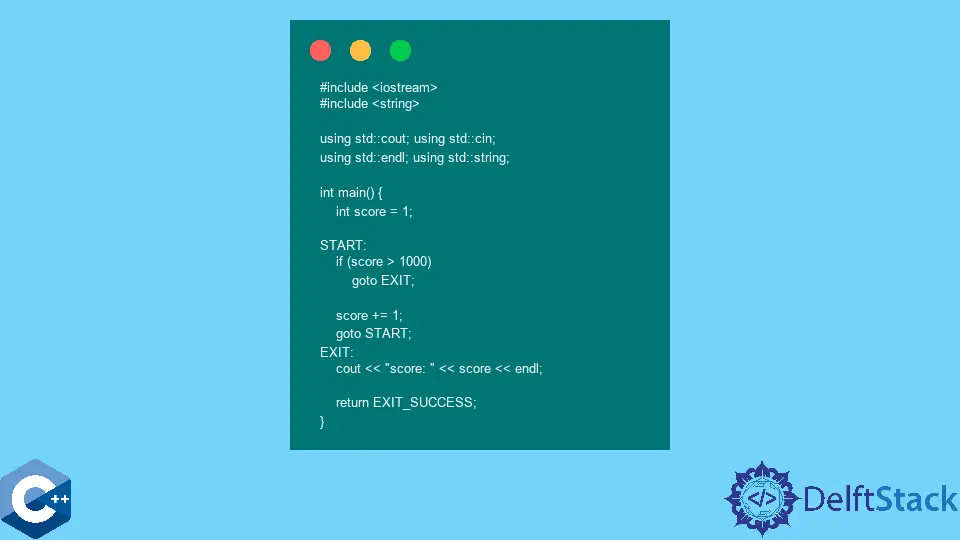在 C++ 中使用 goto 語句

本文將介紹如何在 C++ 中使用 goto 語句。
使用 goto 語句在 C++ 中實現程式控制流跳轉
goto 語句強制程式控制流跳轉到標籤指向的行。通常,C++ 中的任何語句都可以使用特殊符號進行標記,該符號由一個識別符號和一個冒號組成。通常,這些標籤識別符號在函式範圍內隨處可用。因此,它們可以通過位於標籤之前的 goto 語句引用。前面的作用域規則與變數的作用域規則不同——它強制變數在被其他語句使用之前被宣告。
但請注意,goto 不能向前跳轉到作用域並跳過具有初始化程式、非平凡建構函式/解構函式或非標量型別的變數宣告語句。否則,預計會引發編譯器錯誤。在下面的例子中,我們搜尋給定字串在文字中的第一個出現,一旦找到,迴圈就會用 goto 語句中斷,在程式的末尾移動控制。因此,指示失敗訊息的 cout 語句將被跳過,並且僅在沒有字串與使用者傳遞的字串值匹配時才執行。
#include <iostream>
#include <sstream>
#include <string>
#include <vector>
using std::cin;
using std::cout;
using std::endl;
using std::string;
using std::vector;
int main() {
string text(
"Lorem ipsum dolor sit amet, consectetur adipiscing elit."
" Nam mollis felis eget diam fermentum, sed consequat justo pulvinar. ");
string search_query;
cout << "Enter a string to search: ";
cin >> search_query;
std::istringstream iss(text);
string word;
while (iss >> word) {
if (word == search_query) {
cout << "'" << search_query << "' - found in text" << endl;
goto END;
}
}
cout << "Could not find such string!" << endl;
END:
return EXIT_SUCCESS;
}
或者,我們可以使用使用者輸入驗證函式來實現前面的示例,該函式在故障安全行為方面為程式碼增加了更強的魯棒性。cin 成員函式用於實現輸入檢查功能並返回對讀取資料的引用。
#include <iostream>
#include <limits>
#include <sstream>
#include <string>
#include <vector>
using std::cin;
using std::cout;
using std::endl;
using std::string;
using std::vector;
template <typename T>
T &validateInput(T &val) {
while (true) {
cout << "Enter a string to search: ";
if (cin >> val) {
break;
} else {
if (cin.eof()) exit(EXIT_SUCCESS);
cout << "Enter a string to search:\n";
cin.clear();
cin.ignore(std::numeric_limits<std::streamsize>::max(), '\n');
}
}
return val;
}
int main() {
string text(
"Lorem ipsum dolor sit amet, consectetur adipiscing elit."
" Nam mollis felis eget diam fermentum, sed consequat justo pulvinar. ");
string search_query;
validateInput(search_query);
std::istringstream iss(text);
string word;
while (iss >> word) {
if (word == search_query) {
cout << "'" << search_query << "' - found in text" << endl;
goto END;
}
}
cout << "Could not find such string!" << endl;
END:
return EXIT_SUCCESS;
}
在 C++ 中使用 goto 語句來實現迴圈式迭代
goto 語句可用於實現類似迴圈的行為,其中 if 條件評估每次迭代並確定控制是否會退出迴圈。請注意,我們用名稱 START 和 END 標記了迴圈體。基本上,迭代會增加 score 變數,直到它大於 1000。因此,當值計算為 1001 時,迭代會中斷,此時,程式將移動到呼叫 cout 語句的行。
#include <iostream>
#include <string>
using std::cin;
using std::cout;
using std::endl;
using std::string;
int main() {
int score = 1;
START:
if (score > 1000) goto EXIT;
score += 1;
goto START;
EXIT:
cout << "score: " << score << endl;
return EXIT_SUCCESS;
}
輸出:
score: 1001
Founder of DelftStack.com. Jinku has worked in the robotics and automotive industries for over 8 years. He sharpened his coding skills when he needed to do the automatic testing, data collection from remote servers and report creation from the endurance test. He is from an electrical/electronics engineering background but has expanded his interest to embedded electronics, embedded programming and front-/back-end programming.
LinkedIn